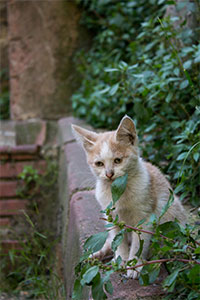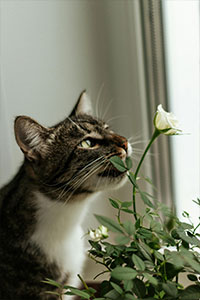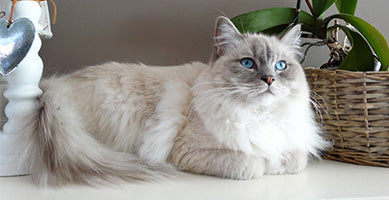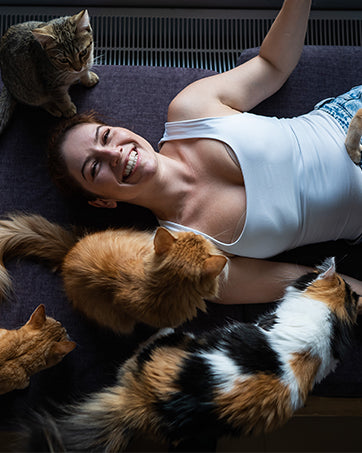Jessica W. Kelvin - Mar.05.2024
Why Do Cats Eat Grass?
7 Insights into Feline Behavior

Written by Vinh Trinh| DVM|4.8.24
How to Tell if Your Cat is Pregnant: Look for the Early Signs
Est. read time: 6 min.
HHave you noticed a change in your unspayed cat’s physical appearance or behavior lately? If so, you might be asking yourself, “Could my cat be pregnant?” and, “What are the signs of a pregnant cat?”
Pregnancy is a critical and exciting phase in the life of a female cat and her owner. Recognizing the early signs of pregnancy can help ensure that your cat receives the right care and nutrition. This blog will guide you through the subtle early indicators of pregnancy in cats, helping you prepare for the potential arrival of new kittens.
How long is a cat pregnant?
Cats are prolific breeders, often capable of becoming pregnant as early as five months old. The typical gestation period for cats is about 64 to 67 days. Knowing whether a pregnancy is planned or accidental can significantly influence the approach to care. Furthermore, understanding the basics of cat pregnancy is crucial for any cat owner, especially if you are not planning to spay your pet.
Early Signs of Pregnancy in Cats
Your cat’s physical appearance will change as they show signs of pregnancy. The typical things that you might expect, like weight gain and increased sleeping habits, are tell-tale signs, but there are other changes that become apparent as the weeks go by.

Increased Appetite:
As her body prepares to nourish multiple kittens, a pregnant cat will often eat more than usual.

© David J. Stang / CC-BY-SA-4.0
Also known as a butterfly palm, the bold areca palm does best in bright, indirect light. One tip? You may want to place your butterfly palm in a tall, heavy pot to keep your cat from digging in it or, ahem, using it as a litter box.
Nipple Changes:
One of the most noticeable signs is the 'pinking up' of the nipples. They will become more pronounced and pinker in color, usually around the third week of pregnancy.
If your cat is pregnant, you’ll see pink (or otherwise pigmented) nipples poking out from underneath her fur. You may also notice that as her pregnancy progresses, her nipples may look swollen and rosier than usual. Breeders refer to the color change as a process known as “pinking up.”

© David J. Stang / CC-BY-SA-4.0
Another of the houseplants safe for cats on our list could also be considered a succulent safe for cats. This plant is a gorgeous choice for those who want low-maintenance plants that thrive in warm weather with filtered light—as long as you keep the soil moist. Hardy baby tears can also be used to cover soil of other houseplants in which your pets might be fond of digging.

Weight Gain:
A gradual increase in weight is common as the pregnancy progresses. This may be accompanied by a more rounded abdomen.
The most commonly noted first symptom of pregnancy in many cats is weight gain. During pregnancy, females will gain 2 to 4 pounds. It is important to keep an eye on your pet’s weight and make a note of any increases. If you notice a quick weight change, that is a good reason to schedule a vet visit, even if you were suspicious that she may be pregnant.
Vomiting
Like human mothers-to-be, your cat can experience what you would call morning sickness. Vomiting can be an early sign of pregnancy, too, usually happening around the 3-week mark. If this happens, check that she’s drinking enough water to stay hydrated. You don’t want her to lose her energy or become sick due to dehydration or lack of fluids.
Vomiting more than 1-2 times a month is always a reason to take your cat to the vet: especially if you’re not aware that she may be expecting. If the vomiting continues and no other symptoms of pregnancy occur, take your cat to the vet as soon as possible. Vomiting could be a sign of other health-related issues; you will want to get that taken care of.
Behavioral Changes
Affection Levels: Many cats become more affectionate and may seek more attention from their owner.
Nesting Behavior: As the birth approaches, your cat may start looking for safe, quiet places to give birth. She might also become more reclusive.
Activity Reduction: Your cat might play less and rest more due to the changes her body is undergoing.
Veterinary Confirmation
Palpation and Ultrasound: A veterinarian can often confirm a pregnancy through palpation after approximately three weeks, or through ultrasound a bit earlier to ensure the health of the fetuses and mother.
Caring for a Pregnant Cat
Proper care during pregnancy is vital. Increase her feed incrementally as her pregnancy progresses, switching to high-quality kitten food as advised by your vet. Ensure her environment is safe, avoiding exposure to harsh chemicals or medications not prescribed by your vet. Gentle handling and a quiet nesting area are also essential as her delivery time approaches.
Conclusion
Recognizing the early signs of pregnancy in your cat allows for better preparation and care. Whether the kittens were planned or a surprise, the health of your cat should always come first. Regular check-ups with the vet can help manage your cat's health during this time, ensuring a safe pregnancy and delivery. If you suspect your cat might be pregnant, consult your veterinarian for confirmation and advice on how to provide the best care.

Cats:Theobromine Toxic Consumption
Most Cats: 1-10 lbs(0.45-4.6 kg), Large Cats11-25 lbs(5-11.4 kg)
Cacao Beans: Most Cats> 0.05 oz, Large Cats> 0.5 0z
Unsweetened Baking Chocolate: Most Cats> 0.2 oz, Large Cats>2 0z
Dark Chocolate: Most Cats> 0.5 0z, Large Cats>7 oz
Milk Chocolate: Most Cats>1.5 0z, Large Cats>16.5 0Z
White Chocolate: Most Cats>360 oz, Large Cats>4000 0z
Cocoa Powder: Most Cats> 01 0z, Large Cats>10z
Cocoa Bean Mulch: Most Cats>0.1 0z, Large Cats>1 0z

Showing making procedure is a good way to guarantee product quality
Stress Relief
Eating grass can also serve as a form of stress relief for cats, providing a calming activity that distracts from anxiety or boredom.


Get customer attention by clean visual and video
Instinctual Actions
Grass eating is an instinctual behavior that may stem from a cat's need to seek out alternative food sources or to induce vomiting to clear their stomachs of indigestible materials.
Article credit: Heidi Cohen (https://heidicohen.com/use-blog-to-sell/)
Digestive Aid
Grass acts as a natural laxative, helping cats pass hairballs or other indigestible items through their digestive tract more easily.
Elimination of Parasites
It's also theorized that grass eating may help cats eliminate intestinal parasites, although this benefit is more anecdotal than scientifically proven.
How to Safely Introduce Grass to Your Cat
Suitable Types of Grass
Certain types of grass are more beneficial and safer for cats, including wheatgrass, which is often sold as "cat grass."
Growing Your Own Cat
Grass
For the safety and health of your cat, consider growing your own cat grass at home. It's a simple and effective way to ensure they're getting a safe product.
Alternative Behaviors and Solutions
Dietary Supplements
If your cat shows an excessive interest in eating grass, it might indicate a dietary deficiency. Consult with a veterinarian about supplementing your cat's diet.
Behavioral Enrichment
Providing toys, climbing structures, and engaging activities can reduce your cat's inclination to eat grass by offering alternative forms of stimulation.
Why Do Cats Eat Grass?
Exploring the curiosity behind this behavior reveals a complex blend of nutritional, psychological, and instinctual factors. Understanding these can help cat owners provide better care and enrichment for their feline friends.
Owner Experiences and Advice
Personal Anecdotes
Many cat owners have observed their pets eating grass and have noted the benefits or concerns that came with it. Sharing these experiences can offer valuable insights for other pet owners.
Expert Recommendations
Veterinarians and animal behaviorists can provide professional advice on managing grass-eating behavior, ensuring it remains a safe and positive experience for your cat.
FAQs
Cats should not eat chocolate ice cream; not only is chocolate toxic to cats, but ice cream often contains toxic ingredient propylene glycol. Ingesting propylene glycol can lead to anemia in cats.
Say it at the end
Understanding why cats eat grass sheds light on their complex behaviors and the natural instincts that drive them. By providing safe, suitable grass and paying attention to the underlying reasons for this behavior, cat owners can ensure their feline companions lead happy, healthy lives.












